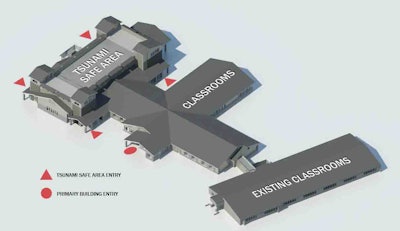
New national construction standards will — for the first time ever in the U.S. — consider the devastating risks posed by tsunamis. The American Society of Civil Engineers has developed this edition of the standards, known as ASCE 7-16, and it’s the first to include a chapter on tsunami hazards, in addition to chapters on seismic, wind and flood hazards.
The tsunami standards are only for steel-reinforced concrete buildings in “inundation zones,” which in the future may be stronger and safer with only moderate increases in cost, experts say. They will not apply to wood-frame structures.
The ASCE 7-16 standards are good for six years and will become part of the International Building Code. In the U.S., it’s up to each state to decide whether to adopt new codes in their entirety, partially in a modified format, or not at all.
The standards were based in part on work done at OSU’s O.H. Hinsdale Wave Research Laboratory, according to Dan Cox of Oregon State University, a professor of civil and construction engineering in the OSU College of Engineering, and one of about 20 engineers on the ASCE subcommittee that developed them.
The subcommittee was a mix of engineering practitioners and researchers from across the nation, Cox said. Led by a practicing engineer in Hawaii, Gary Chock, the committee began its work in late 2010, a few months before the March 2011 earthquake and tsunami that devastated Japan.
“We weren’t reacting,” Cox said. “We were trying to do this in advance. After the 2011 event, interest accelerated regarding how to build things safely in a tsunami zone, and it was important that the subcommittee contained people familiar with how codes work and academic researchers who can bring in the latest advances. Everything was geared toward bringing the best of both into practice.”
The subcommittee used as a starting point a document that had been issued in 2008 by the Federal Emergency Management Agency. Cox’s OSU College of Engineering colleague Harry Yeh had contributed to that document, which was a guideline for designing structures to allow for vertical evacuation, such as climbing to a higher floor.
“We wanted to pull the state of the practice together, and if there were holes in the way we were doing things, we wanted to fill in those holes,” Cox said. “It’s a very rigorous process; there has to be a lot of vetting.”
The large wave flume at OSU’s Hinsdale lab played a major role in producing the data used in developing the tsunami standards, said Cox, formerly the lab’s director and now the head of the Cascadia Lifelines Program.
That program, a research consortium, is working to mitigate infrastructure damage in the Pacific Northwest from a major earthquake on the Cascadia subduction zone.
OSU and eight partners from both the public and private sectors have begun five research projects with $1.5 million contributed by the partners: the Oregon Department of Transportation, Portland General Electric, Northwest Natural, the Bonneville Power Administration, the Port of Portland, the Portland Water Bureau, the Eugene Water and Electric Board, and the Tualatin Valley Water District.
Cox led some of the studies conducted in the flume, and College of Engineering colleague Solomon Yim was a collaborator on a project led by the University of Hawaii.
“One of the big projects was debris,” Cox said. “What force does debris have, and how can you build a column to keep a building in place if debris were to hit it? Now we have equations to use to size that column to withstand a large piece of debris, like a shipping container.”
Already underway on the new standards, Cox and other subcommittee members went to Japan after the 2011 tragedy to study what had worked and what didn’t.
“We got enough information to estimate hydraulic forces and understand damage patterns, and we used this to validate what we were doing,” Cox said. “It was independent, real-world experience to check on whether our approach was valid. These standards are built on lab work, field observation and engineering practice. We used all of the tools available to come up with these standards.”
Cox notes that the tsunami standards will have the most impact on engineers designing and building structures less than about five stories in height. Above five stories, even-stronger building codes will take precedence over codes to protect smaller structures from tsunamis.
While the new standards will add some expense to the cost of a two- or three-story building, the additional amount will be comparatively small.
“The structural cost of a building is less than 10%,” Cox said. “It will be more expensive but it doesn’t triple the cost. When you make a building twice as strong, it doesn’t cost twice as much.”
The new tsunami standard can also be used on retrofit projects, he said.
“We can now apply consistent standards across the hazards,” Cox said. “This allows us to use a consistent methodology, a consistent set of standards so you can design for multiple hazards. It gives options if you decide you want to build in that zone or you have to build in that zone.”


















